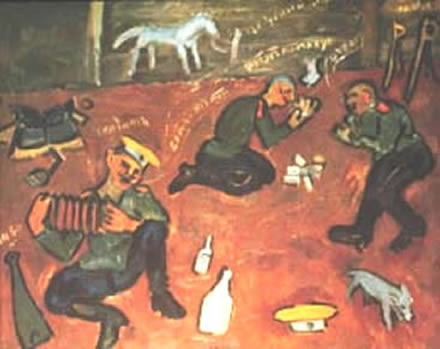Home>Visual
Arts>Avant-garde>Larionov's Soldier Painting
Avant-garde: 1 2 3
4 5
6 7
8 9
10
The ideological unity of the symbolist aesthetic had already
begun to show strains by 1906 (we will discuss these in our
examination of Alexander Blok's play The
Puppet Show). In Symbolism's wake came a dizzying series
of ephemeral avant-garde movements, most of which defined themselves
by overt opposition to the precepts of the symbolists. Nevertheless,
all of these movements grew out of Symbolism and, whatever they
may have claimed, they owed a great deal to it. In painting,
by around 1907 the soft aestheticism of symbolist art gave way
to a primitivist school headed by Mikhail Larionov (1881-1964),
and his wife, Natalia Goncharova
(1881-1962). Both were well aware of postimpressionist tendencies
in France, and were particularly impressed with the later work
of Paul Gauguin and the Fauves. This they combined with an appreciation
of Russian folk, popular, and religious art — including
the "lubok" (popular woodcuts) and traditional peasant crafts
including carving and embroidery — to produce a highly
provocative and original aesthetic.
 One
of Larionov's Soldier Paintings (1909):
One
of Larionov's Soldier Paintings (1909):
Larionov's service in the Russian army provided the inspiration
for a whole series of soldier paintings, including this one
of 1909. Note Larionov's deliberate distortion of perspective
and his use of words on the canvas to create a miniature dramatic
scene.